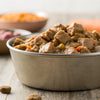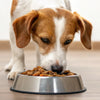How Much Wet Dog Food Do I Feed My Dog? Understanding the Right Portions for Your Furry Friend
- Houndsy
Table of Contents
- Introduction
- The Importance of Proper Feeding for Dogs
- Understanding Feeding Guidelines for Canned Dog Food
- Calculating the Right Amount of Wet Food Based on Your Dog's Weight
- Considerations for Mixing Canned and Dry Food
- Adjusting Feeding Based on Life Stages and Health Needs
- Conclusion
Introduction
Imagine walking into the kitchen after a long day, and your dog greets you with joyful whimpers, tail wagging furiously. But as you prepare their meal, you're struck by a nagging question: How much wet dog food do I feed my dog? If you’re not alone in wondering about this, you’re in good company. Approximately 59% of dogs in the United States are overweight or obese, which highlights the vital role that portion control plays in keeping our beloved pets healthy.
In this comprehensive guide, we’ll delve into the world of wet dog food, exploring factors that influence how much you should be serving your pooch. By the end of this article, you’ll be equipped with the knowledge to determine the right amount of wet dog food your dog requires based on their weight, activity level, age, and dietary needs.
Together, we will go through essential points including:
- The importance of proper feeding for dogs.
- Understanding feeding guidelines for wet dog food.
- Calculating the right amount of wet food based on your dog's weight.
- Considerations for mixing wet and dry food.
- Adjusting feeding based on life stages and health needs.
Let’s embark on this journey to ensure our furry companions receive the care they deserve!
The Importance of Proper Feeding for Dogs
Feeding our dogs may seem straightforward, but multiple factors are at play when it comes to ensuring they receive the proper nutrition. Overfeeding can lead to obesity, resulting in severe health issues like joint pain, diabetes, and heart disease. On the other end of the spectrum, underfeeding can cause nutritional deficiencies, which hinder energy levels and immune function.
Here at Houndsy, we understand the joys and challenges of dog ownership. Our passion for making feeding easier and more enjoyable is evident in our signature product, the Houndsy Kibble Dispenser. Designed to simplify the feeding ritual through perfect portion control, this dispenser highlights our commitment to convenience, quality, and an aesthetically pleasing experience.
Understanding Feeding Guidelines for Canned Dog Food
When we ask, how much wet dog food do I feed my dog?, it's essential to consult the feeding guidelines usually provided on the packaging. While this is a good starting point, it's crucial to recognize that different brands and formulations vary widely.
General Feeding Recommendations
Many feeding guidelines suggest servings based on your dog's body weight. Here's a helpful breakdown:
- Under 10 pounds: 1/4 to 1/2 can per day
- 10 to 20 pounds: 1/2 to 1 can per day
- 20 to 40 pounds: 1 to 1.5 cans per day
- 40 to 60 pounds: 1.5 to 2 cans per day
- 60 to 80 pounds: 2 to 2.5 cans per day
- 80 to 100 pounds: 2.5 to 3 cans per day
While these recommendations serve as a general guide, adjusting based on your dog's individual needs is vital.
Calculating the Right Amount of Wet Food Based on Your Dog's Weight
To accurately determine how much wet dog food to serve, you need to calculate based on your dog's ideal body weight and activity level.
Steps for Calculation
-
Estimate Ideal Weight: If your dog is overweight, consult your veterinarian to establish a healthy weight target.
-
Consult Feeding Guidelines: Refer to the specific feeding guidelines on the wet dog food can for recommendations tied to your dog’s healthy weight.
-
Calculate Daily Portions: For example, if your dog weighs 30 pounds and the recommendation is 1 can per 15 pounds, they would require 2 cans daily.
-
Divide Into Meals: Many pet owners find success feeding their dogs twice a day. If you feed your dog 2 cans daily, you would serve 1 can at breakfast and another at dinner.
-
Monitor and Adjust: Keep an eye on your dog’s weight and appearance to ensure they are receiving the right portion. If they show signs of weight loss or gain, consult your veterinarian for personalized advice.
Example Calculation
Let’s take a 50-pound dog. According to our earlier guidelines, they might need around 1.5 to 2 cans per day. To break it down for meals:
- Daily Total: 1.75 cans
- Per Meal: Approximately 0.875 cans (or roughly 7/8 of a can)
By following these steps, you’ll maintain consistent nutrition for your beloved dog without overwhelming their digestive system.
Considerations for Mixing Canned and Dry Food
Mixing wet and dry dog food can provide a delightful dining experience for your furry friend while enhancing their overall nutrition. If you're curious about how to properly mix wet and dry food and adjust portions accordingly, let’s explore.
How to Mix
-
Adjust Portions: If you’re incorporating wet food, reduce the amount of dry food. A simple rule is to deduct about 1/3 cup of dry food for each half can of wet food.
-
Monitor Calories: Keep a close eye on your dog’s caloric intake to avoid overeating, which can lead to obesity.
-
Experiment with Ratios: Every dog has unique preferences. Adjust the ratio of wet to dry food based on what excites your pup and still meets nutritional needs.
Benefits of Mixing
- Increased Flavor: Mixing can enhance the meal’s appeal for picky eaters.
- Hydration: Wet food can boost hydration levels, especially important for dogs that don’t drink enough water.
- Nutritional Variety: Combining food types can offer a broader spectrum of nutrients, aiding overall health.
Adjusting Feeding Based on Life Stages and Health Needs
Each stage of life brings specific dietary requirements for your dog. Here’s how to adjust their feeding based on age and health.
Puppies
Puppies have unique needs during their growth phase and require more calories than adult dogs. Generally, they may need 2-4 times the amount of food based on their size. Consult your veterinarian for a tailored puppy feeding plan, ensuring you sustain their growth.
Adult Dogs
For adult dogs, regular feeding should align with their activity levels. Highly active dogs may need more food compared to sedentary ones. Periodically review their weight and adjust portions as necessary.
Senior Dogs
As dogs age, their caloric needs often diminish. It’s essential to choose a senior formulation with lower calories and potentially add joint care components like glucosamine. This dietary adjustment can help maintain their muscle mass and overall health.
Conclusion
Understanding how much wet dog food to feed your dog is critical for their longevity and wellness. By considering their weight, age, and activity level, you can make informed decisions about their diet.
At Houndsy, we are passionate about simplifying and enhancing the feeding experience for pets and their owners alike. Our Houndsy Kibble Dispenser is one way we bring this mission to life, offering perfect portion control without sacrificing style or convenience.
If you're ready to elevate your pet feeding experience, we highly recommend exploring the Houndsy Kibble Dispenser. Together, let’s ensure our canine companions enjoy happy, healthy lives!
FAQ
-
How do I know how much canned food to feed my dog?
- Use the feeding guidelines on the canned food label based on your dog's weight. Make adjustments for activity level and consult your veterinarian for personalized advice.
-
Can I mix canned food with dry food?
- Yes! Mixing wet food enhances palatability and hydration. Just ensure you adjust the amount of dry food accordingly.
-
How many meals should I feed my dog each day?
- Most adult dogs thrive on two meals daily. Puppies may need three to five meals, while senior dogs might benefit from two meals depending on their health.
-
What if my dog is overweight?
- Consult your veterinarian to develop a weight management plan including appropriate feeding amounts and exercise.
-
Are there dietary needs for senior dogs?
- Yes, senior dogs require lower calorie diets and can benefit from nutrients supporting joint health. Consult your veterinarian for specific recommendations.












